Ludgershall, Wiltshire
Ludgershall (/ˈlʌɡərʃɔːl/ LUG-ər-shawl, with a hard g) is a town and civil parish 16 miles (26 km) north east of Salisbury, Wiltshire, England. It is on the A342 road between Devizes and Andover. The parish includes the Faberstown housing estate which is contiguous with Ludgershall, and the hamlet of Biddesden which is 1.5 miles (2.4 km) to the east on the border with Hampshire.
| Ludgershall | |
|---|---|
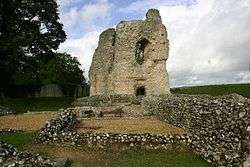 Ludgershall Castle | |
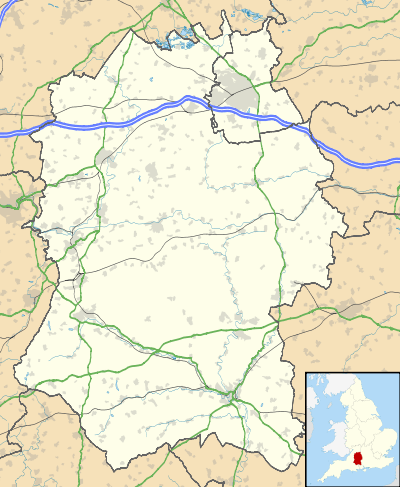 Ludgershall Location within Wiltshire | |
| Population | 4,427 (in 2011)[1] |
| OS grid reference | SU265508 |
| Civil parish |
|
| Unitary authority | |
| Shire county | |
| Region | |
| Country | England |
| Sovereign state | United Kingdom |
| Post town | ANDOVER |
| Postcode district | SP11 |
| Dialling code | 01264 |
| Police | Wiltshire |
| Fire | Dorset and Wiltshire |
| Ambulance | South Western |
| UK Parliament | |
| Website | Town Council |
History
There is evidence of settlement in the late Bronze Age or early Iron Age at Windmill Down on the western edge of the parish.[2]
The Domesday Book of 1086 recorded small settlements at Ludgershall and Biddesden.[3][4] The entry for Litlegarsele reads: "Edward of Salisbury holds Ludgershall. Alfward held it before 1066; it paid tax for one hide (about 24 acres). Land for 3 ploughs. In Lordship 2 ploughs, 3 slaves; 8 Cottagers with 1 plough. Pasture 3 furlongs long and 1 furlong wide; woodland ½ league long and 2 furlongs wide." The value was 100 shillings.
The name "Litlegarsele" may come from "lytel", small and "garsheath", a grassy place, thus a "small grazing area" or "little grass heath".
After the building of Ludgershall Castle in the late 11th century, the village grew to its south and became a medieval borough. The village lay on the old Marlborough to Winchester road, which was an important route in the early 13th century. Later the village lost its importance, and was damaged by fire in 1679.[5] Among the oldest buildings are the Queen's Head public house, from the 16th and 18th centuries,[6] and cottages on Castle Street from the late 17th.[7]
Windmill Hill has been part of the Salisbury Plain Training Area since c.1898, and land in the west of the parish has been used by the Army since 1939. Military activity, including the construction of Tidworth Camp nearby, led to a substantial increase in the population of the parish.[5]
Faberstown
At the beginning of the 20th century, a local MP, Walter Faber, began building to the east of the town on land in Hampshire. This settlement became known as Faberstown. By 1970 Ludgershall and Faberstown were in essence a single village, and in 1992 a boundary change brought Faberstown into Wiltshire.[8][9]
Biddesden
Biddesden is a hamlet to the east of Ludgershall, reached via Faberstown along Biddesden Lane. It is on the Hampshire/Wiltshire border and while most of Biddesden is in Wiltshire, Biddesden Bottom, the site of the Ludgershall Roman Villa, and the public footpath sign thereto,[10] are in Hampshire.
Buildings and structures
Castle
In 1141 the Empress Maud took refuge in Ludgershall Castle as she fled from King Stephen's army. She was accompanied by Milo Fitzwalter and escaped disguised as a corpse to Vies (Devizes) and thence to Gloucester. Some 600 years later a seal was found by a ploughman, bearing a knight in armour and holding a lance shield with the inscription "Sigillum Millonis De Glocestria". It is thought Fitzwalter threw away the seal to avoid identification when he escaped as a beggar. During succeeding centuries the castle was occupied by many distinguished persons and royalty frequently resided there. The village grew around the castle.
The building was turned into a hunting lodge by King Henry III but fell into disuse by the 15th century. The property is now under the care of English Heritage. Three large walls and extensive earthworks remain, although a large section of the original plot is now a private residence.
Cross
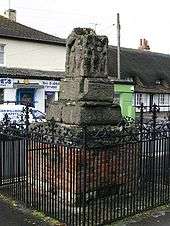
The remains of a Medieval preaching cross known as Ludgershall Cross are situated in the town centre. This is also under the care of English Heritage.[11] It was re-erected some time in the early 19th century in the area that formed the old market place, near the present Queen's Head pub at the end of High Street. It is some 12 feet in height and in 1897, to celebrate the Diamond Jubilee of Queen Victoria, an ornamental iron fence was erected around the cross. The cross has carved representations on four sides but they are badly eroded. It is thought the original sculptured panels represented:
- North side – The Ascencion
- South side – The three Marys
- East side – The Crucifixion
- West side – Command to St Paul
The railings were designed by A. H. Huth and bear a crown in each corner. A local Masonic lodge, The Border Lodge no.3129, consecrated in 1905 and meeting at the old Prince of Wales House hotel building, uses the preaching cross as its emblem.
Parish church
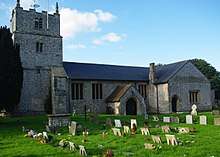
There has been a church at Ludgershall since the 12th century; it was granted to Amesbury Priory in 1228 and united with Biddesden in 1446.[5] Faberstown was added to the ecclesiastical parish in 1945, and since 1979 the name of the parish is Ludgershall and Faberstown.[12]
The parish church of St James has a blocked doorway and a north window from the 12th century.[13] The chancel was rebuilt in the early 13th century and the transepts and north chapel were added in the 14th. The tower was rebuilt or extensively repaired in 1675.[14] Wiltshire Museum, Devizes, has an 1805 watercolour of the church by John Buckler.[15] In restoration of 1873 by J.L. Pearson the roofs were replaced, the tower heightened and the south porch added.[16]
The tower has six bells, two from the 17th century.[17] The building was designated as Grade I listed in 1964.[16]
The font is probably from the 15th century.[16] There is a large monument to Richard Brydges (1500–1588), his wife Jane Spencer and their family, described by Pevsner as "one of the most important of its date in England".[18] Also buried in the church is John Webb (1667–1724).[19] The organ was built by Walker in 1853.[19]
Biddesden House
Biddesden House, now a Grade I listed house[20] and home to an Arabian Horse stud farm, is described in the Imperial Gazetteer of England and Wales (1870–72)[21] as being the chief residence of the parish of Ludgershall.
Corunna Barracks
During the Second World War, Army depots were built to the north and south of Tidworth Road. The War Office transferred the Army Medical Store to a site west of the railway station. The US Army prepared vehicles for the invasion of Europe at the depot in 1943.[8] The barracks were home to 26 Engineer Regiment, Royal Engineers[22] prior to 2015, when they were demolished to make way for military housing.[23][24]
Railway
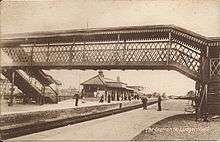
Ludgershall had a station on the Swindon, Marlborough and Andover Railway which was opened in 1882.[25] By 1894 the operator was the Midland and South Western Junction Railway, providing services between Cheltenham and Southampton. A branch from Ludgershall was built to serve Tidworth Camp in 1901, and was opened to public traffic in 1902.[26][27] In 1943 a short spur was added to serve the military depot at Ludgershall, to the south of the main road.
Ludgershall station closed in 1961, along with the line north to Swindon, followed in 1963 by the branch to Tidworth.[28] The spur at Ludgershall and line south to Andover remain open, to allow the Army to transport tanks and other equipment to and from the depot (until its closure in 2015) and onwards to the Salisbury Plain Training Area. There is a level crossing on Tidworth Road.
Ludgershall Town Council and the pressure group Railfuture have been campaigning for the line between Ludgershall and Andover to be reopened for passenger services.[29]
Government
The civil parish elects a parish council which styles itself as Ludgershall Town Council. It is in the area of Wiltshire Council unitary authority, which is responsible for all significant local government functions.
The parish falls in the 'Ludgershall and Perham Down' electoral ward. The ward stretches south east from the Ludgershall area to Perham Down. The total ward population at the 2011 census was 5,874.[30]
Ludgershall was a parliamentary borough which elected two members of parliament (MPs) to the House of Commons from 1295 until 1832, when the borough was abolished by the Great Reform Act. The small size of Ludgershall led to it being cited as an example of a "Rotten Borough".
County confusion
A common misconception is that the town is situated in the county of Hampshire rather than Wiltshire. This problem is compounded by the postal code of SP11 and telephone dialling code of 01264 which both signify it to be in Andover, Hampshire. This confusion is perpetuated by companies using automatic addressing systems based upon the post code. The local newspaper is the Andover Advertiser, based in Hampshire.
The modern town
Ludgershall has developed considerably in the late 20th and early 21st centuries, and is now an important town supporting a number of flourishing businesses and a considerable amount of housing. Part of the former Army depot site became Castledown Business Park.[31] The community is well provided for in terms of entertainment and shops with two pubs and social clubs, a number of small independent traders, and two supermarket chains.
There is a primary school – Ludgershall Castle Primary School, built in 1965 as a secondary school for girls[32] – and a secondary school: The Wellington Academy, opened in 2011.[33]
References
- "Wiltshire Community History – Census". Wiltshire Council. Retrieved 1 March 2015.
- Historic England. "Boundary earthwork and associated bowl barrow on Windmill Hill (1010288)". National Heritage List for England. Retrieved 2 March 2015.
- Ludgershall in the Domesday Book
- Biddesden in the Domesday Book
- Baggs, A.P.; Freeman, Jane; Stevenson, Janet H (1995). Crowley, D.A. (ed.). "Victoria County History: Wiltshire: Vol 15 pp 119–135 – Parishes: Ludgershall". British History Online. University of London. Retrieved 31 March 2018.
- Historic England. "Queen's Head Public House (1036001)". National Heritage List for England. Retrieved 31 March 2018.
- Historic England. "15, 17 and 19, Castle Street (1364528)". National Heritage List for England. Retrieved 31 March 2018.
- "Ludgershall". Wiltshire Community History. Wiltshire Council. Archived from the original on 2 April 2015. Retrieved 1 March 2015.
- "Election Maps". Ordnance Survey. Retrieved 1 March 2015.
- Footpath sign to Ludgershall Roman Villa
- Historic England. "Ludgershall Cross and railings (1285114)". National Heritage List for England. Retrieved 2 March 2015.
- "No. 47946". The London Gazette. 6 September 1979. p. 11285.
- "St James, Ludgershall, Wiltshire". Corpus of Romanesque Sculpture. King's College London. Retrieved 31 March 2018.
- "Church of St. James, Ludgershall". Wiltshire Community History. Wiltshire Council. Retrieved 31 March 2018.
- "Accession number DZSWS:1982.325". Wiltshire Museum. Retrieved 31 March 2018.
- Historic England. "Church of St James (1036004)". National Heritage List for England. Retrieved 31 March 2018.
- "Ludgershall, Wilts". Dove's Guide for Church Bell Ringers. Retrieved 31 March 2018.
- Pevsner, Nikolaus; Cherry, Bridget (revision) (1975) [1963]. Wiltshire. The Buildings of England (2nd ed.). Harmondsworth: Penguin Books. pp. 314–315. ISBN 0-14-0710-26-4.
- "History of St James". St James', Ludgershall and Faberstown. Retrieved 31 March 2018.
- Historic England. "Biddesden House, Ludgershall (1035997)". National Heritage List for England. Retrieved 2 March 2015.
- Imperial Gazetteer of England and Wales (1870–72)
- "Ludgershall soldiers share mine know-how". Retrieved 15 April 2014.
- "Work starts to prepare Ludgershall site for new army homes". GOV.uk. 4 August 2015. Retrieved 19 June 2017.
- Millett, Tony. "Army rebasing: work starts to prepare Ludgershall site for new Army homes". Marlborough News. Retrieved 19 June 2017.
- Mike Oakley. Wiltshire Railway Stations (2004 ed.). Dovecote Press, Wimborne. p. 42. ISBN 1 904349 33 1.
- Historic England. "Tidworth Military Railway (1359011)". PastScape. Retrieved 1 March 2015.
- Crawford, T.S. (1 August 2012). Wiltshire and the Great War. Crowood. ISBN 978 1 84797 447 1.
- "Tidworth". Wiltshire Community History. Wiltshire Council. Archived from the original on 3 March 2016. Retrieved 1 March 2015.
- "Passenger train idea 'on track' for Ludgershall". Spire FM. 17 November 2017. Retrieved 7 August 2020.
- "Ludgershall and Perham Down ward 2011". Retrieved 13 March 2015.
- Castledown Business Park, Ludgershall
- "Ludgershall Castle School". Wiltshire Community History. Wiltshire Council. Retrieved 31 March 2018.
- Dancey, Steve (21 October 2011). "Wellington Academy officially opened by Duke of York". Andover Advertiser. Retrieved 31 March 2018.
External links
![]()
- Official website

- "Victoria County History – Vol 15 pp119-135 – Parishes: Ludgershall". British History Online. University of London. Retrieved 1 March 2015.
- "Ludgershall". Wiltshire Community History. Wiltshire Council. Retrieved 1 March 2015.
- History of Ludgershall castle and cross: English Heritage